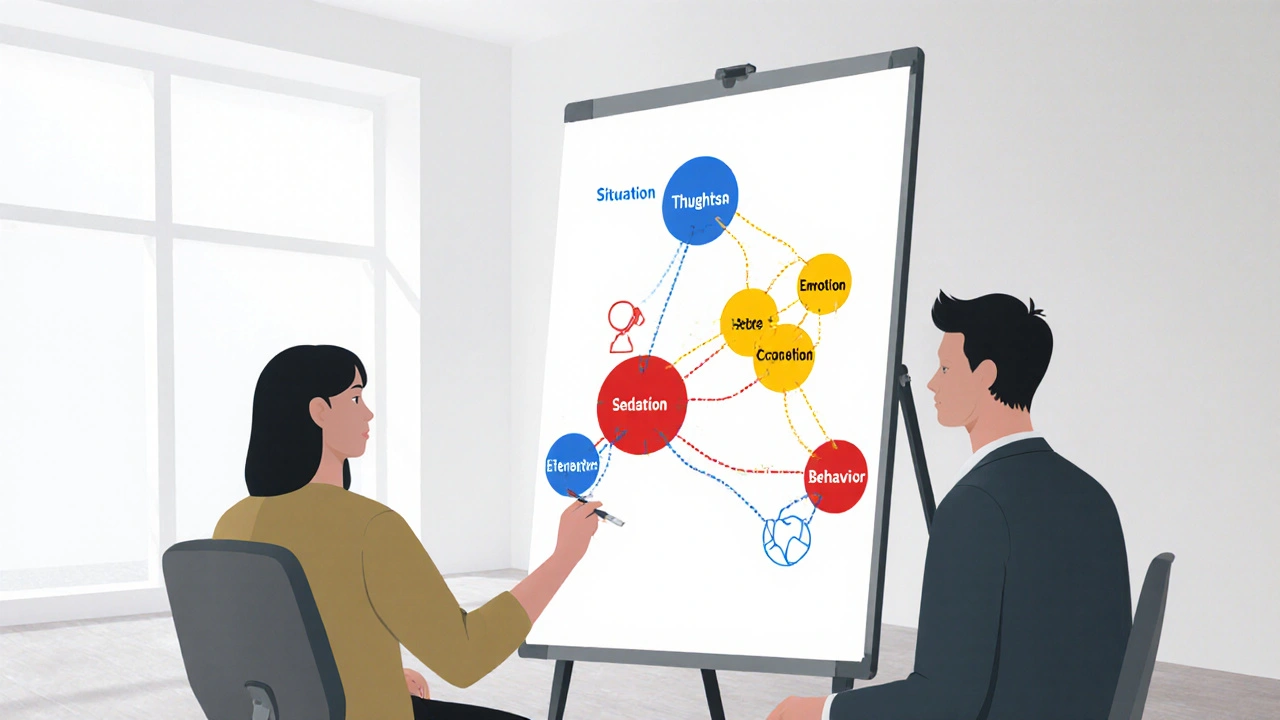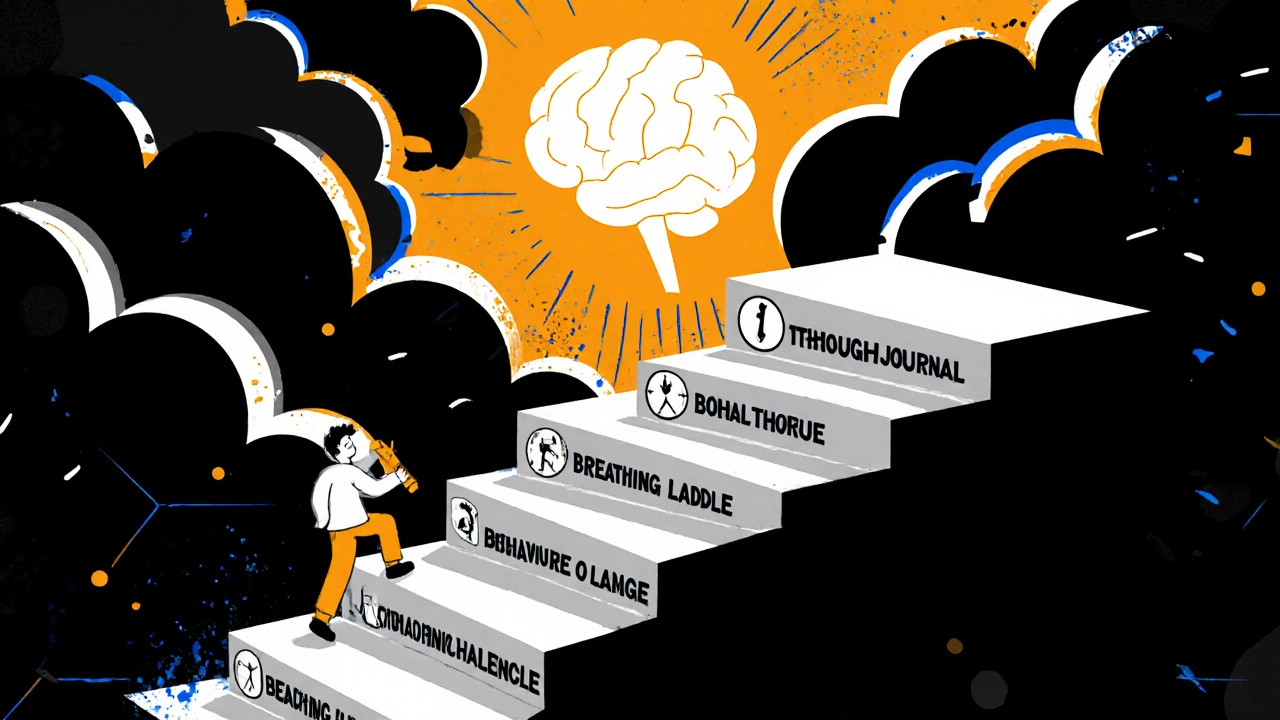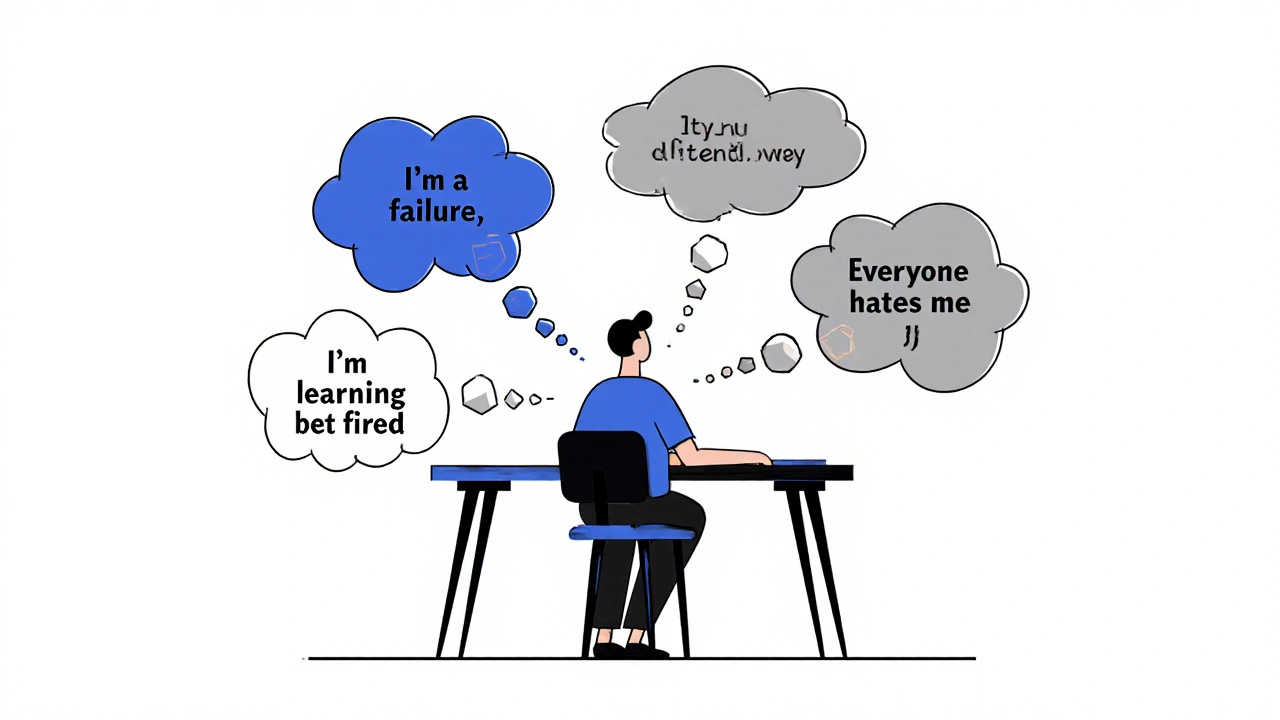When you're stuck in a loop of negative thoughts-worrying about what people think, replaying embarrassing moments, or believing you're not good enough-you're not just being overly sensitive. Your brain is stuck in a pattern. And the good news? There’s a proven way out: cognitive behavioral therapy, or CBT.
What Exactly Is Cognitive Behavioral Therapy?
CBT isn’t some vague talk therapy where you lie on a couch and recount your childhood. It’s practical, structured, and focused on the here and now. Developed in the 1960s by psychiatrist Aaron T. Beck, CBT was born from a simple but powerful insight: how we think affects how we feel and act. If your thoughts are distorted-like assuming the worst will happen or blaming yourself for things beyond your control-your emotions and behaviors follow suit.CBT breaks this cycle by helping you spot those distorted thoughts and replace them with more realistic ones. It also tackles behaviors that keep problems going, like avoiding social situations because you’re afraid of judgment. Instead of just talking about your feelings, you learn skills you can use every day.
It’s not magic. It’s science. Over 2,000 clinical trials have tested CBT since the 1970s. It’s been shown to work better than placebo and often as well as-or better than-medication for conditions like depression, anxiety, PTSD, and OCD. The UK’s National Institute for Health and Care Excellence (NICE) has recommended CBT as a first-line treatment since 2004. So have health systems in the US, Canada, Australia, and beyond.
How CBT Works: The Core Principles
CBT is built on three basic ideas:- Psychological problems are partly caused by unhelpful or inaccurate thinking patterns.
- These problems are also maintained by learned behaviors-like avoiding things that make you anxious.
- You can learn healthier ways of thinking and behaving to feel better.
One of the most famous tools in CBT is the cognitive triad: negative thoughts about yourself ("I’m a failure"), the world ("No one can be trusted"), and the future ("Things will never get better"). These thoughts aren’t facts-they’re habits. And habits can be changed.
Therapists use structured models to track this. The 5-Part Model, for example, looks at:
- Situation (What happened?)
- Thoughts (What went through your mind?)
- Emotions (How did you feel?)
- Physical sensations (Did your heart race? Did you feel tightness in your chest?)
- Behaviors (What did you do?)
By writing this down, you start seeing connections. Maybe you skipped a party because you thought everyone would judge you-and then felt lonely afterward. CBT helps you test that thought: "Did people actually stare? Or were you just assuming?"
What Conditions Does CBT Treat?
CBT isn’t a one-size-fits-all fix, but it’s been proven effective for a wide range of issues:- Generalized anxiety disorder
- Panic disorder
- Social anxiety
- Depression
- OCD (Obsessive-Compulsive Disorder)
- PTSD (Post-Traumatic Stress Disorder)
- Eating disorders
- Insomnia
- Chronic pain
- Substance use disorders
For example, in OCD, a specific CBT technique called Exposure and Response Prevention (ERP) is the gold standard. Instead of washing your hands 20 times to ease anxiety, you’re guided to touch a doorknob and wait-without washing. Over time, the anxiety fades. One 2022 study in the Journal of Clinical Psychology found complete symptom remission in patients after 18 sessions of ERP.
For depression, CBT focuses on breaking the cycle of inactivity. If you’re feeling low, you stop doing things you used to enjoy. CBT helps you slowly reintroduce those activities-even when you don’t feel like it. This isn’t "just cheer up." It’s behavioral activation: a proven method to rebuild motivation through action.
How Long Does CBT Take?
Unlike long-term therapies that can last years, CBT is designed to be short-term. Most people attend 5 to 20 weekly sessions, each lasting 45 to 60 minutes. Many see improvement within 8 to 12 weeks.The NHS in England reports that 74% of people complete their full course of CBT, and 68% report significant symptom reduction. For anxiety disorders, studies show 60-80% of patients improve significantly after 12-16 sessions.
Success depends on effort. You’re not just a passive listener-you’re a participant. Between sessions, you’ll do homework: tracking thoughts, trying out new behaviors, or practicing relaxation techniques. This isn’t optional. It’s where real change happens.

How CBT Compares to Other Treatments
Many people wonder: Should I try therapy, medication, or both?For depression, the NIMH’s STAR*D trial found CBT had a 52% remission rate after 12 months, compared to 47% for antidepressants. But here’s the kicker: relapse rates were much lower with CBT-24% versus 52% for medication alone. That’s because CBT teaches you tools to manage symptoms long after therapy ends.
For anxiety, CBT outperforms other therapies. A 2012 meta-analysis of 269 studies showed CBT had effect sizes of 0.77-1.14, while other therapies averaged 0.58-0.89. That means CBT produces stronger, more consistent results.
But CBT isn’t perfect for everyone. For complex trauma or borderline personality disorder, Dialectical Behavior Therapy (DBT) often works better. For severe childhood behavioral issues, Parent-Child Interaction Therapy shows stronger results. And for chronic pain, newer "third-wave" CBT approaches like Acceptance and Commitment Therapy (ACT) may be more effective.
What People Say About CBT
Real-world feedback is overwhelmingly positive. On Psychology Today, 87% of 1,243 reviews rated CBT as "very effective" or "extremely effective" for anxiety. Reddit users in r/mentalhealth frequently mention "thought records" and "behavioral experiments" as the most helpful parts of therapy.One person shared on HealthUnlocked that graded exposure for social anxiety cut their panic attacks from 15 per week to just 2. Another described how writing down negative thoughts helped them realize they were catastrophizing-assuming the worst without evidence.
Of course, it’s not always easy. About 32% of negative reviews mention homework as a challenge. And 27% say exposure exercises felt overwhelming at first. That’s normal. CBT asks you to face discomfort to get past it. It’s hard work-but it works.
Who Can Deliver CBT?
Not every therapist is trained in CBT. Certified practitioners complete 120-180 hours of specialized training and supervise at least 20 cases. In the UK, the NHS trains therapists in CBT through its Improving Access to Psychological Therapies (IAPT) program. In the US, certification comes through the Academy of Cognitive Therapy.There are also digital options. Apps like Woebot Health, cleared by the FDA in 2021, use CBT principles to guide users through mood tracking and cognitive restructuring. Over 2.1 million people have used it. But studies show in-person CBT is still 22% more effective than app-based versions.
CBT is widely covered by insurance. In the US, CPT codes 90832-90837 are used for billing, and 22 states include it in Medicaid. The NHS offers free CBT through local mental health services.

Limitations and Who Might Not Benefit
CBT isn’t a cure-all. It requires:- Basic cognitive ability to reflect on thoughts
- Willingness to do homework
- Ability to tolerate discomfort during exposure
People with severe cognitive impairment, acute psychosis, or very low motivation may struggle. It’s also less effective if someone isn’t ready to change. That’s why therapists often start with motivational interviewing to build commitment.
Some critics argue CBT focuses too much on symptoms and not enough on deeper personality issues. But recent studies show CBT can even change long-standing patterns of thinking related to personality disorders-something once thought impossible.
The Future of CBT
CBT isn’t stuck in the past. The next wave-called "third-wave" CBT-includes mindfulness, acceptance, and values-based action. Approaches like ACT and Mindfulness-Based Cognitive Therapy (MBCT) are now used for chronic pain, depression relapse prevention, and stress management.Researchers are also exploring personalized CBT. The National Institute of Mental Health’s RDoC initiative is studying how brain activity patterns can guide treatment choices. In the next 5-7 years, we may see algorithms matching specific CBT techniques to individual biology.
AI tools are being developed to analyze thought records in real time, giving therapists instant feedback. But human connection still matters. The best outcomes happen when skilled therapists use technology to support-not replace-the therapeutic relationship.
Where to Start
If you think CBT might help:- Ask your GP for a referral to an IAPT service in the UK or a licensed CBT therapist in the US.
- Check the Beck Institute’s website for free client workbooks and therapist directories.
- Try a reputable app like Woebot or Moodfit if you’re not ready for in-person therapy.
- Be patient. Change takes time. The first few sessions are about learning the model, not fixing everything.
CBT isn’t about becoming a different person. It’s about unlearning habits that keep you stuck. And with over 40 years of research behind it, it’s one of the few mental health treatments you can trust to deliver real results.
